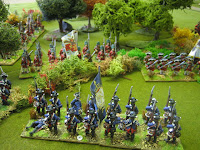The element of surprise did not last long for Lehwaldt. Before his main attacks had a chance to press home the Russians had managed to form a good front line of defense and their reserves were pouring through the woods to support it. (The first three turns ended in early identical initiative rolls and the Prussians only turned one Brilliant Leader card.) The battle broke down into three distinct actions. The first opened on the Prussian right.




HOLSTEIN’S ATTACK
Holstein, vastly outnumbered by the enemy, attacked with reckless abandon. Throwing all caution to the wind his cavalry charged into the Russians. This tactic although suicidal, ultimately served its purpose; it tied down the Russians on that side of the stream for the duration of the battle. The action played out as follows. The first charge of the Prussians was held by the regular Russian cavalry and whilst this melee continued the Cossacks swarmed onto the flank and rear of the engaged Prussians. The first to break were the Prussian hussars, fleeing with Cossacks in pursuit. The Prussian dragoons were also surrounded, but after a very gallant defense they too routed and were cut down to a man. The Russians, feeling all threat removed, began to reorganize before heading back to the main fight developing on the other side of the stream. Indeed the Russian hussars did so. However, the fight was not over. The Prussian hussars rallied and turned on their pursuers, routing them in turn. The bulk of Siblisky’s command was pinned in position again. Towards the end of the battle Holstein’s hussars were finally surrounded and destroyed, but they had served their purpose.




GOLTZ’S ATTACK
Meantime, Goltz and Lupukhin were now engaged in a fierce slogging match. With Fermor’s reserves marching in column through the woods in support Goltz’s position was becoming tenuous. Goltz ordered one of his infantry units into the woods to break up Fermor’s troops before they could shake out into line. This attack was devastating – all but the grenadiers of Fermor’s infantry were broken beyond recall. Now Lupukhin’s position was looking in immenent danger of collapse, but staying power of Russian infantry should never be under estimated. Fermor’s grenadiers formed line and counter attacked in support of Lupukin’s infantry, which also pressed forward, with determination.



SCHORLEMER’S AND DOHNA’S ATTACK
On the Prussian left Schorlemer had been happy to hang back and hold Browne in his position until Dohna’s infantry came up. This gave Browne time to occupy the woods to the left of his artillery with his grenadiers. Dohna’s attack hit at exactly this spot. The grenadiers were sent running and Dohna, now flanking Browne’s line began to advance. But Schorlemer was late to support. Before his cavalry engaged echeloned back to the left, the Russian artillery had destroyed Dohna’s grenadiers and Browne had managed to refuse his exposed flank with cuirassier, and hussars, originally deployed across the stream on the Russian left were arriving in support.

GOLTZ’S ATTACK COLLAPSES AND THE PRUSSIANS WITHDRAW
Goltz’s attack was beginning to crumble under the weight of Russian musketry. His troops were exhausted. Any momentum in the attack had been lost. Russian troops, still fresh, were arriving in numbers. Goltz’s faltering attack now crumbled and his infantry, helping their wounded as best they could, began to retreat. Seeing the battle could not be won, Lehwaldt ordered a general retreat. The battle was over.
CONCLUSION
The battle ended rather historically. The Prussians withdrew and the Russians were unable to pursue. Lehwaldt, with his audacious attack, had succeeded in knocking Apraksin off balance and was duly declared the ‘strategic’ winner.
Thanks to Mark Dudley who lent me his Prussian Red Hussars.